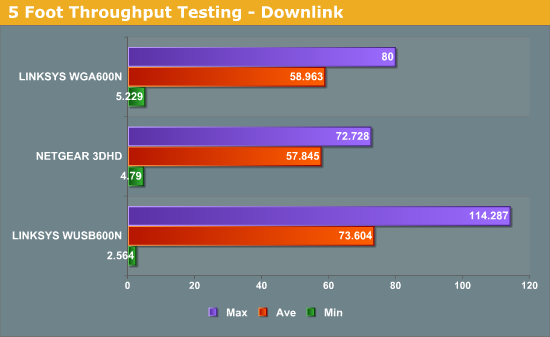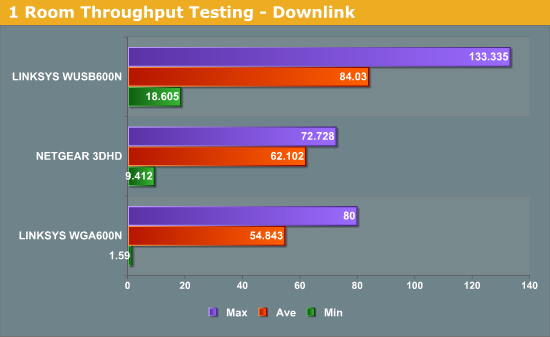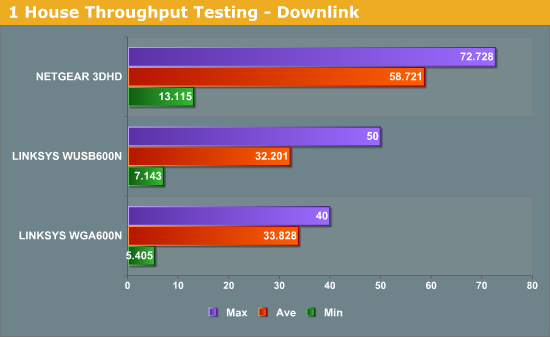Netgear 3DHD Wireless Home Theatre Networking Kit
by Cameron Butterfield on February 25, 2011 7:20 PM EST- Posted in
- Networking
- Home Theater
- NetGear
Location 1 Testing:
Here at the 5 feet optimal range testing, we see that all these adapters are performing extremely well. The NETGEAR falls behind the other offerings at this close range; however, it appears like NETGEAR's maximum throughput rate may possibly be limited in order to improve reliability (note the 72.728Mbps max that is prevailant throughout all the tests.)

Location 2 Testing:
We actually see both the 3DHD and the WUSB600N adapters improve their speeds in the other room; it appears that the adapters we are using don't like being as close together as 5 feet. However we do see the WGA600N sart to lose some throughput.

Location 3 Testing:
Things really get shaken up here at the whole house testing. The NETGEAR 3DHD kit is barely taking a hit in performance at this range. Keep in mind that this is real world testing on opposite ends and differing floors of a 2500 square foot house. Here we see that both the other 5GHz adapters are only working at 38% and 64% of their one room apart testing, and the 3DHD is almost doubling their average throughput.











37 Comments
View All Comments
ChronoReverse - Friday, February 25, 2011 - link
Why do the positions of the tested devices vary across each chart? It would be much better if the NETGEAR 3DHD was always the first one in each graph.JarredWalton - Friday, February 25, 2011 - link
It's a glitch with the multibar charts in our engine. Sorry.Slash3 - Saturday, February 26, 2011 - link
30 seconds in MS Paint's cut/paste can reverse the positions. :)JarredWalton - Saturday, February 26, 2011 - link
30 seconds in the graphing engine. Then save that image from your browser onto your drive. Open that image up in Paint (or more likely, Photoshop). Then rearrange the bars so that they're in the positions you desire. Don't mess up the text or the spacing of the bars. When you're done, save the file, upload it back to the server, and then modify the HTML to reference the appropriate file. Yeehaw! I'd guess more like 5 minutes. Now do that for every graph you want to modify.I'll make a note to our engine guy that sorting of multi-series charts doesn't work. Then hopefully we can get that fixed for the future. Having done manual creation of charts in the past, though, I can tell you that it isn't even remotely fun. In fact, the old graphing engine was seriously one of my least liked parts of writing articles. The new engine is worlds better, but it isn't perfect.
LeftSide - Friday, February 25, 2011 - link
Wow, I wireless device that is reliable, has consistent throughput, and is easy to set up. This is a first.danjw - Friday, February 25, 2011 - link
You mention that for short range there were lower priced options that performed just as well for wireless HDMI, so which ones are those?nubie - Friday, February 25, 2011 - link
I think he meant that the other devices it was compared to, not HDMI links.If you needed to go one room over, or through one wall or floor, the other devices reviewed were faster.
Kyser Soze - Friday, February 25, 2011 - link
It's testament to the quality of anandtech's site that they check throughput on various levels of emotional content in films. No other tech sites offer this service. I for one am looking forward to finding out if some stuttering occurs during the Shawshank Redemption, but not, for instance, in Attack of the Clones.Can my old netgear handle romantic comedies?
queequeg99 - Friday, February 25, 2011 - link
This is a pretty funny comment. Did the author intend to refer to a detailed scene with lots of movement?Exelius - Friday, February 25, 2011 - link
If you're somewhat technical, just pick up a pair of compatible wireless devices and load them with DD-WRT, then set one of them up in bridge mode.I have a pair of 5 year old Linksys WRT54Gs that I have doing exactly this. Throughput isn't spectacular by ethernet standards (averages about 30 mbps) but it's more than enough to stream 720p Netflix to my PS3. The devices are about 50 feet apart and cost me about $300... 5 years ago. They can certainly be found for less now. Bonus with DD-WRT is that you can basically "overclock" the wireless radios and operate them with a higher signal strength (though be careful; heat quickly becomes an issue and the case on one of my devices is warped from high heat output in a poorly ventilated area.)
I'm sure this solution is easier to set up, but honestly, it's a set-it-and-forget-it solution. Any self-respecting tech nerd should be able to set this up in an hour or two and enjoy the fruits for years. That said, wireless links can be finicky and a pain in the ass to diagnose when things go wrong, so wired is always preferable even when speed isn't a factor (it doesn't get screwed up by using the microwave.)